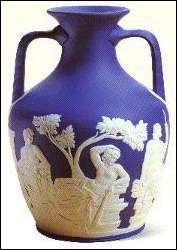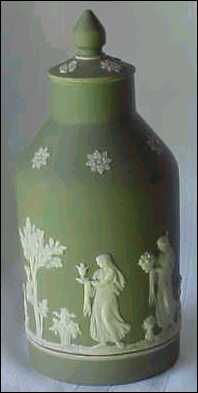![]()
Jasper Ware
|
Jasper Ware |
![]()

Jasperware - a durable unglazed
porcelain
most characteristically blue with
fine white cameo figures inspired
by the ancient Roman Portland Vase.
![]() Jasper is white in its natural state and is stained with metallic oxide
colouring agents. The most common shade is pale blue, but dark blue, lilac, sage
green, black, and yellow were also used. The earliest jasper was stained
throughout and was known as "solid," whereas the later varieties were
coloured only on the surface and were known as "dip."
Jasper is white in its natural state and is stained with metallic oxide
colouring agents. The most common shade is pale blue, but dark blue, lilac, sage
green, black, and yellow were also used. The earliest jasper was stained
throughout and was known as "solid," whereas the later varieties were
coloured only on the surface and were known as "dip."
![]() Decorations, in the Neoclassical style and usually
white, were made in separate moulds and applied to the body of the piece.
Objects made of jasper were varied and included vases, plaques, tableware,
cameos, furniture mounts, and portrait medallions.
Decorations, in the Neoclassical style and usually
white, were made in separate moulds and applied to the body of the piece.
Objects made of jasper were varied and included vases, plaques, tableware,
cameos, furniture mounts, and portrait medallions.
![]() The finest examples of the medallions were modelled by
the English sculptor John Flaxman and by Wedgwood's principal modeler, William
Hackwood. Outstanding are Wedgwood's 1790 reproductions in jasper of the
Portland Vase (excavated from a tomb outside Rome in the early 17th
century), one of which is now in the British Museum, London.
The finest examples of the medallions were modelled by
the English sculptor John Flaxman and by Wedgwood's principal modeler, William
Hackwood. Outstanding are Wedgwood's 1790 reproductions in jasper of the
Portland Vase (excavated from a tomb outside Rome in the early 17th
century), one of which is now in the British Museum, London.
![]() Jasperware is still produced by Wedgwood's today. www.wedgwood.co.uk
Jasperware is still produced by Wedgwood's today. www.wedgwood.co.uk
| The familiar
densely uniform stone ware in solid colours ornamented in a contrasting
hue was Josiah Wedgwood's most important contribution to ceramic
art.
Because of the popularity of the combination of a solid blue base with white bas-relief ornamentation the beginning collector identifies that colour combination as Jasper when in fact the pure jasper body is white. It was the ability of this new ceramic material to take an admixture of uniform colour that gave the wide range of combinations that mark the development of the range of decorative wares that Wedgwood and his successors at the Wedgwood potteries made into their trademark product.
|
|
 |
The Jasper body was the
product of years of painstaking experiments. It was in 1772 that Josiah
started his quest for the new ceramic material and not until November 1774
that he made his first bas-relief figures.
By the time that his partnership with Thomas Bentley was ended with Bentley's death in 1781 the range of Jasper products produced was extensive. Cameos, intaglios, and small busts were produced. Vases, plaques and bough pots were crafted of the new material. |
| The crowning achievement and one that sealed jasperware as the most sought after decorative pottery in England and the Continent was his reproduction of the famous Portland Vase in 1790 after 4 years of laborious trials. | |
THE IMITATORS The importance of his discovery and the popularity of his designs produced a spate of imitators seeking to capitalize on the new range. Adams was the ware that most resembled Wedgwood's in all but colour. Others whose quality approached the original were Palmer, Wilson Neal and Hollins. On the Continent Sevres brought out
a range of blue porcelain decorated in white and Meissen brought out a
range of blue porcelain with integrally cast white embossing named
Wedgwoodarbeit, literally Wedgewood Work. The flattery of the imitators
was certainly sincere. |
|
|
RESUMPTION OF PRODUCTION By the time of Josiah's death in 1795 jasper ware was at the height of fashion. By 1811 its popularity was in the wane and the production of jasper products tailed off. By 1817 vases were no longer being produced and by 1829 production in jasper had virtually ceased but experimentation continued. In 1844 production resumed using jasper as a dip and for applied decoration to a new white porcelain body. Solid jasper was not manufactured again until 1860 and even then the Wedgwood grandsons considered their new attempts as inferior to the Old Wedgwood produced by their grandfather. Jasper production was not interrupted again until 1941 and World War II forced its abandonment. Production resumed in 1948 with a new composition that more closely resembled Josiah's original. Since that time production of newly designed jasper pieces has fueled the collectable market. Christmas and Mother's day plates have been an example of marketing aimed directly at the collector.
|
|

Wedgwood Green Dip Jasper Tea Canister &
Cover Circa 1920 6 3/4 inches High.
Marked Wedg Eng,
Applied White Classical Figures below Florets
![]()
questions / comments? email Steve Birks steveb@netcentral.co.uk